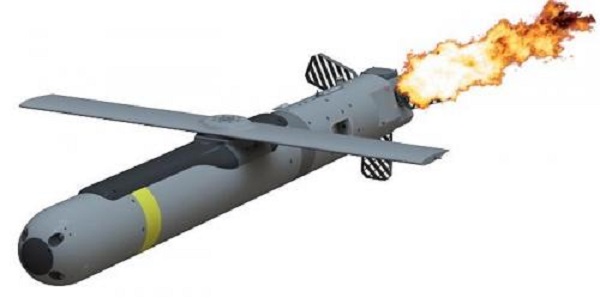Originally appeared at ZeroHedge
As global counterterrorism operations show no signs of slowing down, U.S. Special Operations Forces (SOF) are receivingthousands of light, gliding missiles that are smaller and more powerful than an AGM-114 Hellfire and fired from a Lockheed C-130 Hercules above the modern battlefield.
Dynetics Small Glide Munition. (Source: Defense News)
In recent years, insurgent groups have outsmarted American precision-guided weapons launched from an unmanned aerial vehicle (UAV) with fast traveling vehicles. However, a new powerful gliding munition can chase down and destroy these fast-moving targets.
Dynetics Small Glide Munition. (Source: Aviation Week)
According to the United State Special Operations Command (SOCOM) report about an upcoming contract award, it signed a deal with Alabama-based defense contractor Dynetics for the supply of about 4,000 more of the 59-lb. GBU-69B Small Glide Munitions (SGM) over the next four years.
The GBU-69B Small Glide Munitions (SGM) can glide for more than 20 miles and slam into a moving target traveling up to 70 mph with its lightweight, 36-lb. warhead, which is more powerful than a Hellfire, but has about half the weight coming in at 59-lb.
Breaking Defense points out that Dynetics’ secret to weight reduction is in “a lighter tube thanks partly to the fact that the SGM is unpowered, and uses wings that unfold after launch to glide to its target.” The company told Breaking Defense that the weapon was designed to be “modular” so that the SGM could fit on a wide variety of platforms.
In a justification document breaking down why it was not purchasing more SGMs, SOCOM said it wanted to “expeditiously complete development, integration, test, and fielding an SGM capability for the AC-130W, AC-130J, and other Special Operations Forces (SOF) platforms” because “the combat need is immediate.” The document also discussed how SOCOM had terrible luck with another comparable munition, which “was removed from service on SOCOM aircraft due to failure to achieve lethality performance and high cost to redesign to meet mission requirements.”
The contract, which could be awarded as early as July, will require Dynetics to provide “700 SGMs in 2018 and 2019, with 900 more in 2020,” said Breaking Defense. The number is expected to increase to 1,000 per year in 2021 and beyond.
Highlighted in the recent Department of Defense’s National Defense Strategy (2018), counterterrorism operations in the Middle East, Yemen, Eastern Africa and Libya will be abundant well into the 2020s. According to the newest US Army’s Training and Doctrine Command, or TRADOC, these operations will be considered hybrid wars, that are small, fast-paced, and rely on precision-guided munitions to protect Special Operations Forces.
Dynetics told Breaking Defense that the SGMs laser-guided munition uses lattice control fins at the back of the missile are similar to the GBU 43/B Massive Ordnance Air Blast, and the GBU-57A/B Massive Ordnance Penetrator.
In the past, SOCOM tested several other lightweight munitions, but none seemed to pan out with successful field tests. SOCOM tested Raytheon’s Griffin, Northrop Grumman’s Viper Strike, and Textron’s G-CLAW. Here is what the justification document said:
- SOCOM “phased the Viper Strike out of the inventory due to failure to achieve lethality performance, and high cost to redesign to meet mission requirements.”
- Textron’s G-CLAW “is 2-3 years behind the SGM in maturity and experienced failures in its first flight test with a seeker,” and
- Raytheon’s Griffin “does not address the required aspects of the 360 degree employment zone, launch signature, and support engagement scenarios in which attack azimuth and impact angle must be precisely controlled. At this time, there is no viable alternative to the SGM.”
Dynetics further told Breaking Defense that the company is experimenting with strapping the SGMs to fighter jets and helicopters, and “nothing that would preclude it from unmanned or light aircraft or gunship derivatives.” Dynetics added that the SGM could be an excellent fit for the Army’s lightweight precision munition program.
Perhaps, lightweight munitions for SOCOM’s hybrid wars in Africa and the Middle East is another way of saying, the military cannot afford to field overpriced munitions, as its endless wars could undoubtedly bankrupt this nation.








